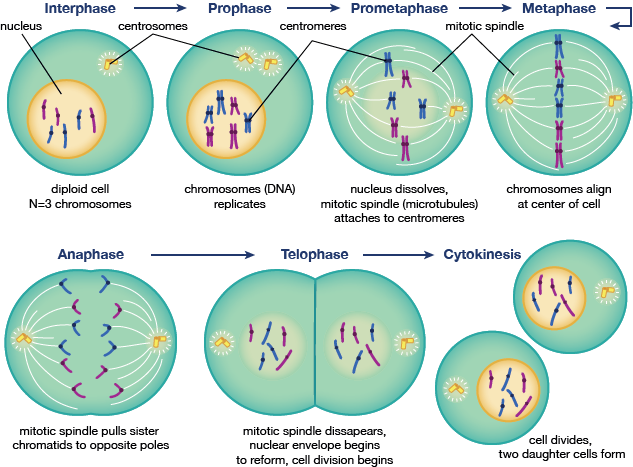Cell Cycle part 2
Now the cell should have double the amount DNA after interphase. The next phase is m-phase. The m-phase consists of mitosis (separation of 1 cell nucleus to 2 nuclei) and cytokinesis (cytoplasmic division or whole cell division). There are 4 steps in mitosis. To help understand this concept, I will explain the structure of a chromosome. A chromosome is formed during mitosis to help in nuclear division. A chromosome has two sides, each side is a copy of the other(interphase), therefore, each side separates into its own nucleus so the new cell has an exact copy of the parent cell's DNA.
The first phase is called prophase. During prophase, the chromosomes become visible from chromatin and the nucleolus disappears. The next phase is called metaphase. Here, the chromosomes line up in the center and fibers called spindle fiber attach to the chromosomes centromere from both sides. The next step, anaphase, the spindle fibers pull on the chromosomes where each copy is separated to either side. Finally, telophase, a phase where the nucleus forms and the chromosomes dissipate into chromatin.
Right after telophase, cytokinesis occurs. Now the whole cell will be divided and each would have it own nucleus. This new cell wouldn't start to go through interphase, rather, it would go into a G0 phase, where this whole process is stopped until the body directs the cell to replicate again.

The first phase is called prophase. During prophase, the chromosomes become visible from chromatin and the nucleolus disappears. The next phase is called metaphase. Here, the chromosomes line up in the center and fibers called spindle fiber attach to the chromosomes centromere from both sides. The next step, anaphase, the spindle fibers pull on the chromosomes where each copy is separated to either side. Finally, telophase, a phase where the nucleus forms and the chromosomes dissipate into chromatin.
Right after telophase, cytokinesis occurs. Now the whole cell will be divided and each would have it own nucleus. This new cell wouldn't start to go through interphase, rather, it would go into a G0 phase, where this whole process is stopped until the body directs the cell to replicate again.


Consulta IPVA 2020, consulte agora e agende sua vistoria.
ReplyDelete?well.
ReplyDeleteis the chromatin material is the freely scattered chromosomes in the nucleus?
in that way to facilitate gene transcription for cellular processes.